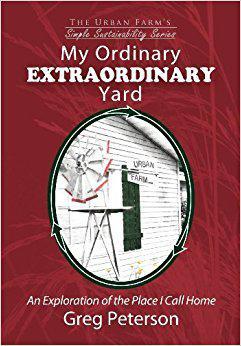“TO THE WEEDS, TO THE WILDERNESS”
A letter to our readers about inspirational compelling films
and the art of ‘re-wilding’
from Guest blogger: Vivienne de Courcy
Dear Urban Farmers:
Brace yourselves, because I am going to talk to you today about how “lawns” can save the world. But, its initially because of my lawn experience that I embarked on a journey which became the film Dare to be Wild, premiering on Netflix this week (April 1st, 2018). The question is for filmmakers, what kind of ideas are we going to cultivate through our art? For me, a story is a seed because it feeds the growth of an idea. An idea takes root in the imagination, and a vision blossoms.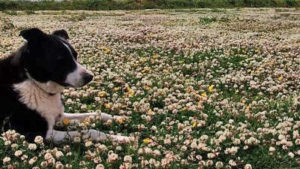
Several years ago when I started writing scripts, my most trusted friend said “Why not make that script you wrote about the 16th century Irish prince – full of violence, sex, and political intrigue? That will sell easily.” But I have never been drawn to convention. As filmmakers, we must frequently fly in the face of convention, be original, and use creative interaction with audiences to achieve our goals. Besides, after my wonderful experience with clover lawns I had a goal.
The Hares Corner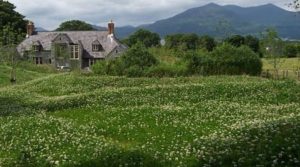
You see, long ago in Ireland, there was a fashion among ancient farmers to keep a corner of their fields uncut at harvest time – a refuge for small native animals and plants – it was known as “the Hare’s Corner” and the ancient farmers believed it was for luck. Those ancient farmers were throwing a lifeline to the wilderness. And this really interested me.
You may have noticed that darkness, horror and hopelessness have become a kind of creeping ground cover in the world of cinema for about twenty years. They may excite and even fascinate, but they seldom inspire. All these films are proof the movie industry can monetize “darkness” – I guess many identify with hopelessness and alienation. For others, the majority I think “dark edginess” has become fashionable – a badge of “cool.”
Films which Illuminate Solutions for Humanity
But movies which elevate the human spirit, and inspire creative interaction with audiences, can illuminate solutions for humanity, and make money. At least for my friends, young and old, it’s a relief to find uplifting movies, though extremely rare. But why would you pay $15 on a Friday night to be depressed, or worse, number? Why trawl through tv streaming sites for endless dark offerings. Most would rather be entertained and enlightened.
But then again, why should it matter to us what happens in the space of a two hour movie? Well, consider this, one of the best ways to deliver new ideas—is to give your audience something they don’t expect, connect to their hearts, so the idea reaches a tipping point, spills into the zeitgeist, and creates “the New Normal.”
Catharsis
My mother – an English teacher, who directed local theatre, often used to say “If you want your play to succeed, your audience needs to be crying laughing or crying crying.” It’s my view that drama only really works if an audience experiences catharsis – that bonding with a story which opens up emotions – pity, fear, admiration – which results in renewal and restoration – and perhaps, most importantly, the seed of new ideas.
Psychiatrists will tell you its not logic that motivates us to act – you can’t blind us with science – its how we feel that moves us towards action. Maya Angelou said “I’ve learned that people will forget what you said, will forget what you did, but people will never forget how you made them feel.” Great films have the potential to tap into that wellspring of human emotion, which illuminates the world for us, make us feel pity, fear, admiration, makes us think, and hopefully, maybe, makes us act.
Films Today – the Bad News
But what happens when the media culture poisons the well? What happens when directors want their film to be described as “dark, edgy, tortured and twisted? According to the American Psychiatric Association, by age 18, children will have seen 200,000 acts of violence through various media outlets—including 40,000 murders — from movies, TV, music, video games and more.
It makes the Roman Coliseum look like a tea party, doesn’t it? I don’t for one minute suggest that ALL movies need to explore this alternative –I have loved many dark and violent films from The Godfather, to Pulp Fiction, Dark Night, American Sniper, Avatar, Hamlet – there’s a pile up of corpses! But great movies all! But this is partly why I chose not to take my friend’s sensible advice and start my directing career with a script full of violence, sex and intrigue. I wanted to do something entirely different. But by fully accepting this media culture, do we contribute to the inventory of murders, or is there a viable alternative?
Balance
I believe we need to offer audiences more alternatives – compelling and hopeful visions of what the world can be. We need to introduce audiences to characters who show what everyday people, acting together, can achieve. The reality is, for the last 15 years we’ve been overwhelmed with “slash, bash, and crash.” We need a few less “dick flicks” and quite a bit more enlightenment. We need to radically redress the balance between inspirational, as opposed to, violent films.
The Choice
A movie can desensitize. Or it can galvanize. A movie can manipulate, or motivate. A movie can cast us as apathetic consumers of a two-dimensional product or, it can move us to become conscious participants in an interactive creative process.
So, as a filmmaker, there is a choice. And that choice is not whether to shape the collective imagination, or to “just make movies.” Because like it or not, all movies impact the collective imagination. In other words, the real choice comes down to the content we choose as filmmakers because all movies, for better or worse, impact how we as a people envision the future, and our role in shaping that future.
Here’s an irony for you: movies that dwell on dark dystopia allow viewers to ignore the genuine catastrophes that threaten our world – the consequences of our own human folly: the loss of habitat, of wilderness, of a diverse and life-sustaining environment which is why I chose to make a romantic adventure story about re-wilding.
Lifeline to the Wilderness – A New Dawn
Of course, from Pope Francis, the Chinese Premier to the Indian Premier – the environment, and our need to preserve wild places is finally in the foreground. But we, all of us, still have to act, each in his own way.
What typically motivates us to act? Fear, greed, power, war, sex, jealousy, tribalism…Unfortunately, many actions inspired by these emotions frequently culminate in some form of cruelty or brutality – so often, too often, seen in movies.
What prevents us from acting? I think ‘apathy’ is a huge enemy – climate change is complicated; we humans feel no sense of imminent threat even though all logic tells us we should. And of course, vested interests with power and money – lots of it – resist the necessary legislation.
While America is back-tracking, China is taking action on the environment because of the dramatically deteriorating air quality and the soaring incidence of cancer. But we appear incapable of reacting to the ominous warning the collapse of the bee population implies, simply because we haven’t yet felt its impact on our daily lives.
Thus, for filmmakers – we need to offer a vision people can relate to, a vision that inspires them to respond, a vision that gives them tools to act in their own best interests.
Re-Wilding – Mary Reynolds
In 2003, I met a young Irish landscape designer who created wild gardens. I asked her to designed a wild garden for me, and she told me her dream was to preserve the remaining wild places on earth. Her core idea is that all our gardens should be wild – or at least have a wild refuge – a Hare’s Corner.
This idea was so radical at the time that it stunned, but ultimately enthralled, the established gardening fraternity at the Royal Horticultural Society, and beyond. The fruits of her idea, and the ideas of many other visionaries like Mary, are visible everywhere today as people try to bring nature back into their lives; people like Urban Farmers.
It took 10, yes, 10 long years, about the same length of time it takes a sapling to grow into a tree, to make our film Dare to be Wild based on the incredible true story of that landscape designer, Mary Reynolds, and her goal to win the Chelsea Flower Show with a wild garden to raise awareness for the wilderness.
A wild woman with a wild idea inspired me to act. 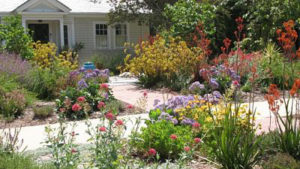
We need re-wilding everywhere: Central Park to Regents Park, the White House lawn to your lawn. In this effort to make re-wilding the New Normal, we don’t have fear, greed, power, war, sex, jealousy, or tribalism on our side. But we have beauty, fun. And we may have fashion. Beauty, fun, and fashion can be powerful. Mary Reynolds made me see that.
Films & Dare to be Wild – the Inspiration to Act
I remember the films that made the greatest difference in my life—indeed, in the lives of many. I remember seeing “Gandhi,” and marveling that you could bring about change on a national, even international level, by entirely peaceful means.
I realized there are good, even great, films that affect us momentarily, forgotten almost before we leave the cinema. And then there are films, even small films, little ‘jewels,’ that in some mysterious and magical way, impel us to act – to change the way we live, and interact with others, for the better.
If you ask people which movie characters have most influenced them, many will not cite superheroes, but recall ordinary people – real or fictional – who achieved extraordinary things in their own universe however humble.
- The brave Stasi Agent in The Lives of Others.
- The merciful husband in Amour.
- Minny Jackson, the enlightened nanny, in the Help.
- Erin Brockovich, the unlikely whistleblower.
- The lawyer dying of AIDS in Philadelphia Story – classic catharsis – the audience’s pity turned ignorance to empathy.
- Billie Elliot who attained his dream to become a ballet dancer – and was the catalyst for getting us dancing again… And dance lightens our load, as does a walk in the wild.
- Mary and Christy. The central characters in our feature film Dare to be Wild, Mary Reynolds and Christy Collard, you’ll see them as on screen actors on Netflix, are real people; real environmentalists whose actions in the story can inspire actions outside the story. They want to change the world, one garden, one vast desert at a time.
Lawns
From 17th century, lawns became a status symbol available only to the rich, which trickled down to suburban lawns and parks today; high maintenance and environmentally destructive. Scottish immigrants transferred the lawn to American golf courses and tennis clubs, and lawns of “regulated specification,” became de rigeur in suburbs. But, in Florida or California, lawns demanded even more herbicides, pesticides, and intense watering. Regulations made a particular kind of sterilized lawn “normal” to keep up the “tone” of a neighborhood. If you didn’t maintain your lawn you could be fined. If you attempted to turn your lawn into a native wild flower meadow you would most certainly be fined. But, drought has meant California now gives rebates for ripping up lawns in favor of native species – the New Normal.
But, in Florida or California, lawns demanded even more herbicides, pesticides, and intense watering. Regulations made a particular kind of sterilized lawn “normal” to keep up the “tone” of a neighborhood. If you didn’t maintain your lawn you could be fined. If you attempted to turn your lawn into a native wild flower meadow you would most certainly be fined. But, drought has meant California now gives rebates for ripping up lawns in favor of native species – the New Normal.
Yet people the world over still go to extraordinary lengths to install and maintain these expensive toxic lawns. Why? Because years ago, it became ‘fashionable’ to build a barrier between the domestic and the wild.
Bees
Except this barrier doesn’t help us anymore – not when the bees are threatened with extinction. Bees are the most important insect pollinators, pollinating over 90% of the world’s 245,000 flowering plant species. Without bees and other pollinators, we won’t last very long as a species; in fact four years is the estimate.
The State of California opted to label herbicides carcinogenic. A revolutionary step for the environment. Four years ago, the EU banned pesticides which gave bees a haven to recover. But regrettably, under pressure from aggressive lobbying during the transatlantic fair trade negotiations, the ban was lifted. The pesticides are back. The bee populations are declining. But Aldi supermarkets became the first chain to ban pesticides from its food products.
Picture the Future: Wild gardens, Forest gardens – the New Normal
We travel the world over to experience places of untouched natural beauty, yet most gardens and city parks, are often quite the opposite. SO PICTURE THIS: A normal mowed lawn, sterilized by herbicides and pesticides in a garden of sprayed, cultivated flowers – literally designed to make wildlife difficult. NOW PICTURE THE ALTERNATIVE: A clover lawn surrounded by native plants in a dynamic wild forest garden with a tree and a food source.
A normal lawn can’t support one bee! But a clover lawn supports several pollinators and more. Clover lawns are inexpensive, and don’t need pesticides or herbicides so there is no toxic downside for beehives. Clover lawns link us back to the rhythms of dynamic nature, help the bees, and so help us. Even the smallest garden can fast track nature’s aim to become a multi-layered woodland eco-system. And it’s not about letting our land “go wild.” In fact, Mary Reynolds’s book Garden Awakening explains exactly how to become more guardian than gardener as well as how to design “wild” beautifully. After all, we are part of nature. But the reality is that although we don’t yet feel it we are on the edge of eco-system collapse.
Conclusion:
One person alone cannot reverse the loss of habitat in a conventional garden. But when we see one young woman dare to make a difference – to plant the seeds of a new possibility, then more and more of us begin to make a difference, too. Imagine your clover lawn, than a hundred such lawns, and then a thousand of them: all those pretty gardens and parks transformed into thriving ecosystems, supporting threatened species – beautiful – and life sustaining. So creative interaction with audiences can redress the balance, not only between inspirational versus violent films, but also the balance between man and nature. Helping this outcome is the goal of Dare to be Wild.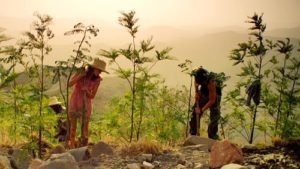
When you and I engage in collective action, we express to others – and to ourselves – something vital about our values, our priorities, and our identities, something deeply true about our membership in the human community – we do something to protect our children and the generations that hopefully will come after us. This is the essence of creative interaction with art and culture. Great stories have the power to move us, inspire us, even give us the courage to act individually and collectively for the better. I believe that a story is a seed. A seed that can blossom into something inspirational, beautiful, uplifting: A seed that leads us to action.
So, here’s to art, to daring to re-wild, and to the power of dreams in Dare to be Wild.
Vivienne
About this author:
 Vivienne DeCourcy came from a long family line of market gardeners, academics and rebels, yet somehow found herself having lived for 20 years in a Chicago high rise practicing corporate finance law. She really missed the landscape of her childhood – between Dublin and West Cork, and after getting breast cancer in her early thirties, she left corporate law, followed a childhood dream and started writing scripts. She went back home and bought a small hill farm where her love for natural landscape, writing, and trying to make the farm hers, came together and gave her the opportunity to write the script for Dare to be Wild, released spring 2016.
Vivienne DeCourcy came from a long family line of market gardeners, academics and rebels, yet somehow found herself having lived for 20 years in a Chicago high rise practicing corporate finance law. She really missed the landscape of her childhood – between Dublin and West Cork, and after getting breast cancer in her early thirties, she left corporate law, followed a childhood dream and started writing scripts. She went back home and bought a small hill farm where her love for natural landscape, writing, and trying to make the farm hers, came together and gave her the opportunity to write the script for Dare to be Wild, released spring 2016.
Dare to Be Wild Movie: on Amazon and iTunes – Click here for the Trailer
*Disclosure:
Some of the links in our podcast show notes and blog posts are affiliate links and if you go through them to make a purchase, we will earn a nominal commission at no cost to you. We offer links to items recommended by our podcast guests and guest writers as a service to our audience and these items are not selected because of the commission we receive from your purchases. We know the decision is yours, and whether you decide to buy something is completely up to you.


 Vivienne DeCourcy
Vivienne DeCourcy 



